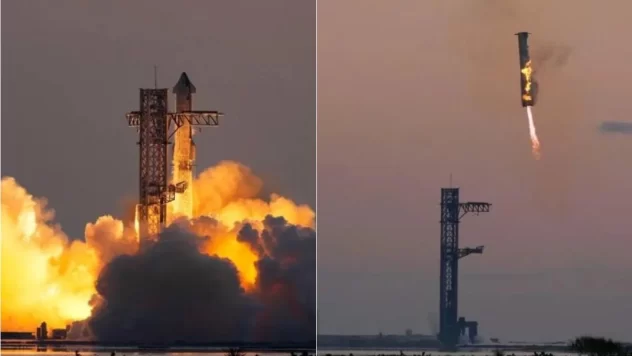SpaceX successfully launched the latest test flight of Starship on Sunday morning — its fifth since 2023 — the most powerful rocket system ever built that could one day be used to take humans to the Moon and Mars.
Liftoff of the Super Heavy rocket, carrying the uncrewed Starship spacecraft, occurred at 8:25 a.m. ET (7:25 a.m. CT) during a 30-minute launch window that opened at 8 a.m. ET from SpaceX’s Starbase facility in Boca Chica, Texas.
For the first time, this demonstration mission included an ambitious attempt to maneuver the 230-foot-tall booster rocket onto a giant landing structure after it had burned through most of its fuel and broken away from the upper Starship. The Super Heavy was successfully caught mid-flight with a pair of massive metal grippers, which SpaceX calls “chopsticks.”
Meanwhile, the Starship continued to fly on its own, using its six onboard engines, before practicing a landing maneuver over the Indian Ocean. SpaceX does not expect to recover the upper craft.
The goal of each milestone is to determine how SpaceX could one day quickly recover and reuse Super Heavy rockets and Starship spacecraft for future missions. Rapid reuse of rocket parts is seen as essential to SpaceX’s goal of dramatically reducing the time and cost of getting cargo — or people-carrying spacecraft — into Earth orbit and deep space.
Ultimately, SpaceX plans to use the Starship capsule as a lander that will carry NASA astronauts to the lunar surface as early as 2026, as part of the Artemis III mission , and the company has government contracts worth up to nearly $4 billion to complete the task. Eventually, SpaceX also hopes to have Starship put the first humans on Mars.
Starship development has so far focused on a series of increasingly complex test flights, beginning in 2019 with brief hop tests of a vehicle dubbed “ Starhopper ” that initially hovered just inches off the ground. More recently, the company has moved on to more daring launches of the fully stacked Starship capsule and Super Heavy booster.
The first test launch of a Starship and a Super Heavy , called an integrated test flight, took place in April 2023. The sole purpose of this launch was to get the 121-meter vehicle off the launch pad. And it did, before exploding minutes after flying over the Gulf of Mexico.
SpaceX is known for embracing setbacks in the early stages of spacecraft development, saying these failures help the company quickly implement design changes that lead to better results. The company’s goals have become more ambitious with each new launch.
The latest test launch, the fourth in SpaceX’s integrated test flight campaign, took off in June. Both booster and spacecraft, despite displaying a badly charred and wobbly wing during the webcast, survived reentry into Earth’s atmosphere and completed landing maneuvers over the ocean, marking a significant step forward.
SpaceX took its testing even further by recovering the Super Heavy rocket after launch. Ultimately, SpaceX plans to recover and reuse both the Super Heavy and the Starship spacecraft. But recovering the rockets is a natural first step, as SpaceX has extensive experience in this field.
Landing booster rockets after flight is a feat that SpaceX mastered with its smallest rocket, the Falcon 9. That rocket’s boosters have been recovered multiple times. Boosters from that rocket have landed softly on sea or land platforms after more than 330 launches, allowing them to be refurbished and flown again. SpaceX says this has reduced its costs, allowing it to offer lower prices than the rest of the rocket market.
However, Starship is a much more powerful and complex system. With 33 engines at its base, each more powerful than one of the nine used on the Falcon, the Super Heavy rocket offers about 10 times more thrust at liftoff.
Rather than attaching landing legs to the side of the Super Heavy like those that adorn a Falcon 9’s booster, SpaceX has built a special pylon to support the Super Heavy’s return to solid ground, in the hopes that this will further speed up the recovery process.
The tower, nicknamed “ Mechazilla ” by SpaceX CEO Elon Musk for its resemblance to a metallic Godzilla, has massive metal arms. The arms, or “sticks,” can be used to stack and move boosters and spacecraft around the launch site before liftoff, and are essentially designed to catch the vehicles in mid-air as they return to Earth.
Musk’s vision is that, in the future, the toothpick arms could simply turn around and return a rocket to the launch pad within minutes of returning, allowing the vehicle to take off again once refueled, perhaps as little as 30 minutes after landing, the CEO said in a June 5 interview.
It’s a bold vision. And SpaceX is still in the early stages of perfecting exactly how capture works.
Musk acknowledged during a July interview posted on YouTube that SpaceX’s goal for this flight “sounds crazy,” though “it has a pretty good chance of working.”
“We’re not breaking physics,” he said, “so success is one of the possible outcomes here.”
SpaceX snagged the Super Heavy booster on the condition that “myriad different vehicle and platform criteria were met,” according to the company’s website, which required “healthy systems on the booster and pylon and a manual command from the mission flight director.”
Had the attempt been scrapped, Super Heavy would have attempted its ocean landing maneuver again.
The attempt came about seven minutes after launch, with the Starship spacecraft coasting for nearly an hour before making a controlled splashdown in the Indian Ocean.
One issue Starship encountered during its fourth test flight in June, Musk added, was the loss of heat shield plates, or thousands of small black hexagons affixed to the outside of the spacecraft that are supposed to protect the vehicle from extreme temperatures during reentry. According to Musk, the loss of a large number of these plates greatly hampered the vehicle’s ability to attempt a soft landing.
“Due to the loss of the plates … the front fins were so fused it was like trying to control them with little skeleton hands,” Musk said, adding that the fourth flight landed about 9.7 kilometers (6 miles) from the planned splashdown site in the ocean.
The company says on its website that it has conducted a “complete overhaul of its heat shield, with SpaceX technicians spending more than 12,000 hours replacing the entire thermal protection system with state-of-the-art plates, an ablative reinforcement layer and additional protections between the fin structures.”
This could help Starship better survive the brutalities of reentry.
A successful flight could push the company to take on much more ambitious projects. For example, SpaceX must figure out how to refuel a Starship while it is parked in orbit. This maneuver will be necessary to provide the huge vehicle with enough propellant to make the trip to the Moon.
If the company had missed its targets or caused substantial damage to its launch facilities, it could have raised questions about further delays to NASA’s lunar ambitions.
Artemis, NASA’s flagship human spaceflight program, aims to put astronauts on the surface of the Moon for the first time since the Apollo program ended more than 50 years ago.
The federal space agency has already warned that its goal of making the first manned landing on the lunar surface in 2026 could be slowed by the development timelines for Starship.

